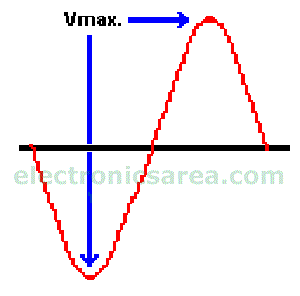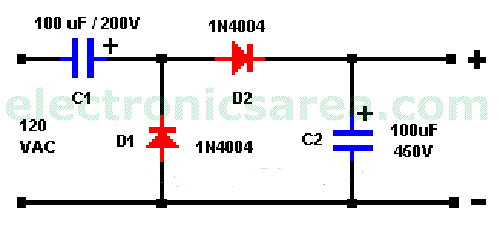Half Wave Voltage Doubler
Voltage doublers produce twice as much DC voltage as a common rectifier could produce. They can be implemented in two different ways: half wave voltage doublers and full wave voltage doublers. In both cases the ripple voltage frequency is the same as that of the input voltage.
In the process of full-wave rectification of traditional rectifiers, the frequency of the ripple voltage is twice the frequency of the input voltage.
In the Halft Wave voltage doubler circuit, the voltage applied to the diodes is twice the normal voltage, so they must withstand twice the normal voltage. The voltage characteristic of the capacitors depends on the particular circuit.
The advantage of the Half Wave voltage doubler is that it has a line, which is common to the input and output (see diagram). This line can be taken as common or ground and can be connected to the chassis or metal base of the equipment to be fed.
The ground or common terminal must be well identified, so as not to make an inverted connection with unpleasant consequences. If this were done, the chassis or metal base of the equipment would be connected to the “+” terminal.
Half Wave Voltage Doubler Operation
In the first negative half-cycle of the input wave, the diode D1 is directly polarized and allows the current to pass through the capacitor C1. The capacitor is charged to the peak value of the input voltage. If the peak value is Vmax., then this capacitor is charged at this voltage. In this cycle diode D2 is inversely polarized and does not conduct.
In the next half-cycle of the input voltage (positive half-cycle), D1 diode is reverse polarized and does not conduct. D2 diode is directly polarized and the current flows through the capacitor C1, the diode D2 and the capacitor C2.
At the beginning of the negative half-cycle, the capacitor C2 is discharged, but C1 is charged at Vmax (peak value of the input voltage). The capacitor C2 will then be charged at twice the input peak voltage. The current input peak voltage and the accumulated voltage at the capacitor C1 are added together.
Important: It has been assumed that the input voltage is 120VAC. For a design using a 220/240 VAC, the capacitors must be replaced by higher-voltage ones.






